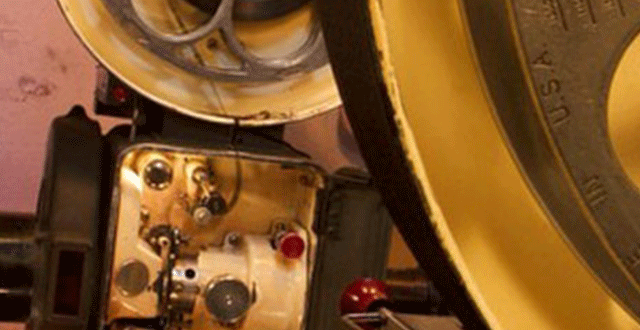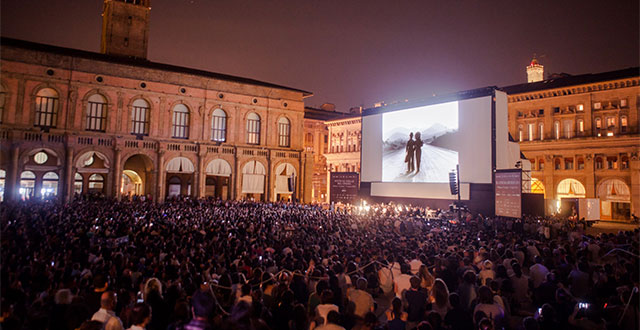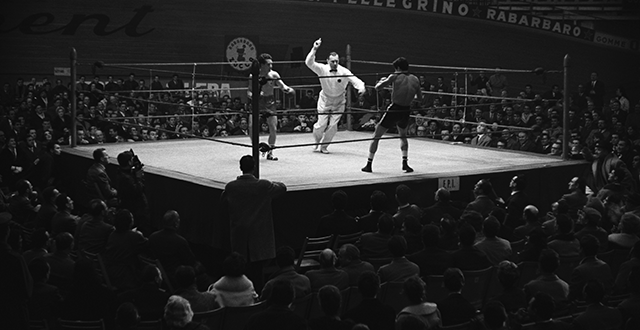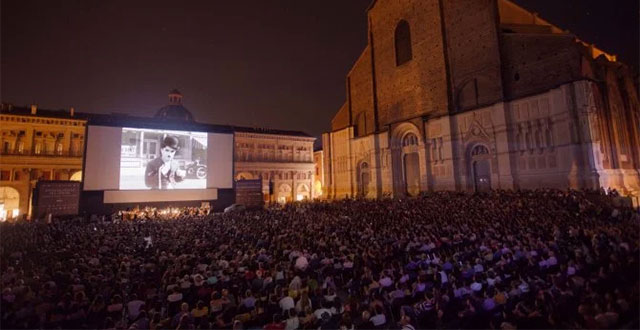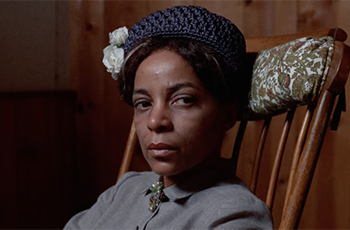News
AMIA and Alamo Drafthouse Team Up To Offer 35mm Projection Workshop
AMIA and Alamo Drafthouse Team Up To Offer 35mm Projection Workshop
Three-day Event Provides Film Projection Training and Insight from Industry Experts in Partnership with The Film Foundation
Additional Partners Include Kodak and Boston Light & Sound
LOS ANGELES (July 7, 2016) — The Association of Moving Image Archivists (AMIA) and Alamo Drafthouse, in partnership with The Film Foundation, will host a three-day film projection workshop offering expert-led training for managers, curators and projectionists in the proper presenting of 35mm film in theaters. The hands-on, educational event will be held August 22-24 in Austin, Texas, at the Alamo South Lamar location. Additional partners supporting the symposium include Kodak and Boston Light & Sound.
As digital technology has presented new opportunities to filmmakers and exhibitors, it has also negatively impacted the availability of prints for theaters showing 35mm film. Many of those prints come from archives and similar institutions that cannot replace these valuable assets should they become damaged. At the same time, this lack of access to 35mm film prints and the predominance of digital projection has reduced the number of projectionists who have experience in handling film. This makes training in the proper handling and projection of film prints critical, and the need for this workshop essential.
“While digital has become the primary exhibition format, many theaters continue to show 35mm film prints,” said AMIA President Andrea Kalas. “We want to provide working professionals and projectionists who want to continue their education with the special skills to work with rare and archival prints to ensure that audiences will continue to enjoy many films in their original 35mm format. Bringing AMIA together with the Alamo Drafthouse and The Film Foundation, as well as Kodak and Boston Light & Sound, helps to foster an appreciation for this revered cinema experience.”
The workshop will offer a hands-on tutorial for projectionists and theater staff working with 35mm film prints and will focus on film preparation and projection as well as special stipulations for archival projection, coordinating with lending institutions, and paperwork. Instructors will include specialists in archival projection, as well as training from Boston Light & Sound and Kodak.
“I love digital projection for new release films, but only a tiny sliver of our vast film history will ever make it to the DCP format,” said Alamo Drafthouse CEO Tim League. “As an industry, we must continue to preserve, protect and carefully screen 35mm films and maintain our 35mm projection equipment. The day we stop is the day cinema as we know it is dead.”
Participants will receive industry-wide recognition for completion of the workshop, indicated by a certificate from AMIA. Last year’s one-day event was sold out and met with positive reviews. This year, AMIA has expanded the program to include additional courses and hands-on training.
“Preservation and restoration is vital; equally important is sharing these films with an audience,” said Margaret Bodde, The Film Foundation’s Executive Director. “With this workshop, AMIA and Alamo Drafthouse are helping to ensure that archival and studio prints are properly handled and projected, allowing new generations the unique experience of seeing 35mm film projected onto the big screen.”
“AMIA and Alamo are great stewards of film,” said Steve Bellamy, President of Kodak’s Motion Picture Film division. “Kodak is all in on film and it is critical to support the projectionist and theater community in every way we can. Workshops and events are a fantastic way to ensure that we are developing these skills in communities across the world.”
The fee for workshop participants is $250, and attendance is limited. For more information, and to register, visit http://www.projectionworkshop.com/.
#
ABOUT AMIA
As the world’s largest international association of professional media archivists, the Association of Moving Image Archivists (AMIA) is uniquely poised to bring together a broad range of experts. Members represent film studios, corporate and national archives, historical societies, labs, post production, universities, footage libraries and more. Because of this diverse membership, AMIA provides an opportunity to interact with every facet of the field and a single forum to address the best ways to preserve and provide access to our media heritage in digital and analog formats. For further information, visit www.AMIAnet.org and follow AMIA onFacebook, Twitter (@AMIAnet) and Instagram (@AMIArchivists).
ABOUT ALAMO DRAFTHOUSE
Tim and Karrie League founded Alamo Drafthouse Cinema in 1997 as a single-screen mom and pop repertory theater in Austin. 17 years later, the now 20-location chain has been named “the best theater in America” byEntertainment Weekly and “the best theater in the world” by Wired.com. The Alamo Drafthouse Cinema has built a reputation as a movie lover’s oasis not only by combining food and drink service with the movie-going experience, but also introducing unique programming and high profile, star studded special events. Alamo Drafthouse Founder & CEO, Tim League, created Fantastic Fest, a world renowned film festival dubbed “The Geek Telluride” by Variety. Fantastic Fest showcases eight days of genre cinema from independents, international filmmakers and major Hollywood studios. The Alamo Drafthouse’s collectible art gallery, Mondo, offers breathtaking, original products featuring designs from world-famous artists based on licenses for popular TV and Movie properties including Star Wars, Star Trek & Universal Monsters. The Alamo Drafthouse Cinema is expanding its brand in new and exciting ways, including Drafthouse Films, which has garnered two Academy Award nominations in its short three-year existence and Badass Digest, an entertainment news blog curated by veteran journalist Devin Faraci. More information about the Alamo Drafthouse is available on the official website at www.drafthouse.com.
ABOUT THE FILM FOUNDATION
The Film Foundation is a nonprofit organization established by Martin Scorsese in 1990 dedicated to protecting and preserving motion picture history. By working in partnership with archives and studios, the foundation has helped to restore nearly 700 films, which are made accessible to the public through programming at festivals, museums, and educational institutions around the world. The Film Foundation’s World Cinema Project has restored 28 films from 20 different countries representing the rich diversity of world cinema. The foundation’s free educational curriculum, The Story of Movies, teaches young people – over 10 million to date – about film language and history. For more information, visit: www.film-foundation.org.
ABOUT KODAK
Kodak is a technology company focused on imaging. We provide – directly and through partnerships with other innovative companies – hardware, software, consumables and services to customers in graphic arts, commercial print, publishing, packaging, electronic displays, entertainment and commercial films, and consumer products markets. With our world-class R&D capabilities, innovative solutions portfolio and highly trusted brand, Kodak is helping customers around the globe to# sustainably grow their own businesses and enjoy their lives. For additional information on Kodak, visit us at kodak.com, follow us on Twitter @Kodak, or like us on Facebook at KodakNow.
The HFPA Honors Another Classic: Japan’s “Ugetsu Monogatari” at Bologna’s Cinema Ritrovato 2016
Armando Gallo
For the second year running the Hollywood Foreign Press Association enjoyed a special spot in the annual Il Cinema Ritrovato(Rediscovered Cinema) which takes place in Bologna, Italy. The festival showcases classic, rare and restored movies and has become a must-see event for cinephiles.
The HFPA has sponsored Martin Scorsese’s Film Foundation which has restored more than 90 classic films. This year one of those titles, the Japanese masterpiece Ugetsu Monogatari by legendary director Kenji Mizoguchi, was featured in all its original poetic beauty which was honored with the Venice’s Silver Lion in 1953.
The film was presented at the Arlecchino Cinema on the second day of the Festival to a sold out audience after an introduction by HFPA member Elisa Leonelli, herself an alumni of Bologna University, and Margaret Bodde, President of the Film Foundation who praised the generosity of HFPA for making Ugetsu and many other restorations possible. Martin Scorsese joined on by video message from New York, where he is still busy with his new film Silence.
“I first saw Ugetsu on TV in 1958”, he iconic director told the Arlecchino audience. “And I have been obsessed ever since by its beauty and poetry. It was very hard to find the various elements to restore and save this masterpiece and I have to thank our friends of the Hollywood Foreign Press for making it happen. We did a 4K digital restoration working from a master positive copy and a negative dupe. We worked at Cineric in New York and I had fantastic help from Masahiro Miyajima, who worked with cinematographer Kasuo Miyagawa for 30 years. I deeply love what Cinema Ritrovato and the town of Bologna is doing by showing these movies in the right way. I visited Bologna and the Cineteca, but not Cinema Ritrovato Festival and I promise to come soon.”
Every year the festival’s program expresses the power of film. Almost 500 titles were presented this year, from June 25 to July 3, at the Bologna Cineteca 4-screen complex and in various theaters in the center of this vibrant Italian city. Over 100.000 spectators celebrated the Festival’s 30th anniversary with an international audience: 3.500 festival passes sold to visitors coming from more than 50 different countries. 500 film archivists and FIAF members came from all over the world.
The historic Piazza Maggiore, a jewel of Italian Renaissance, is the setting for the festival’s free open air screenings. It was very appropriate that Cinema Ritrovato would open June 25th in the Piazza with Charlie Chaplin’s classic masterpiece Modern Times with the accompaniment of a full orchestra. During the week Chaplin’s The Kid (1922) was also shown and its soundtrack, scored by Chaplin himself for the television version of the movie, was rediscovered and performed for the first time in its entirety by the excellent Orchestra Comunale di Bologna. Buster Keaton’s movies had the same inspiring presentation.
Italian film critic and lecturer Giuliana Muscio added that Cinema Ritrovato has been kind of a secret for international aficionados, “But things are changing,” she said. “People now come from all over world. Alexander Payne and George Lucas are just some of the people who restore movies privately and then show them here. On opening night I saw whole families at Chaplin’s Modern Times and heard parents explaining to the children behind me why Chaplin makes fun of the unions and fights for the workers. It is very important to see the great memories of film of the past to do better for tomorrow.”
"Cinema Ritrovato also creates new audiences for silent films and restored masterpieces with no borders. Again, the HFPA can become a valid sponsor of Cinema Ritrovato; not just for the money you already give, but also having a voice in what needs to be done and restored.”
Martin Scorsese on Visconti’s Rocco and His Brothers
Martin Scorsese
The film-maker pays tribute to Luchino Visconti, whose cinematic masterpiece Rocco and His Brothers has been restored to its original glory.
Luchino Visconti was one of the greatest artists in the history of cinema. He had a fascinating life, which was intertwined with many different strands of European art and culture.
Visconti came from the Milanese branch of one of Europe’s oldest families, whose roots can be traced back to the early 13th century. He might have appeared as a character in one of his own films about the aristocracy, such as Senso or The Leopard – that’s the life he was born into. But at a certain point in the 1930s, his passion for theatre, opera and the cinema set him on a radically different path.
Visconti had a kind of apprenticeship with Jean Renoir and worked as an assistant on some of the pictures he made during the period when he was associated with the French Popular Front – Renoir was actually the one that gave him the idea for his first film, Ossessione, an adaptation of The Postman Always Rings Twice. Visconti’s artistic and political lives became almost one and the same – he started making films and directing theatre during the war years, the same period in which he joined the Communist party and worked with the Resistance.
He has often been referred to as a great political artist, but that’s too limiting and frozen a description. His sense of European history was vast and he knew the lives of the rich and powerful first hand – but at a certain point he became drawn to understand the other side of life, that of the poor and powerless. He had a strong sense of the particular manner in which absolutely everyone, from the Sicilian fishermen in his neorealist classic La Terra Trema to the Venetian aristocrats in Senso, was affected by the grand movements of history.
Visconti directed 14 features in his lifetime, each one extraordinary. Some, such as Senso, The Leopard and Rocco e i suoi Fratelli [Rocco and His Brothers], are among the greatest in the history of the art form. Written by Visconti and his long-time collaborator Suso Cecchi D’Amico (along with the contributions of four other writers), Rocco was based on elements of Ghisolfa Bridge by the Milanese writer Giovanni Testori, but it was also inspired by themes found in Thomas Mann’s Joseph and His Brothers and Dostoyevsky’s The Idiot. Visconti follows the fortunes of Rocco (Alain Delon) and his three brothers Simone (Renato Salvatori), Ciro (Max Cartier) and Luca (Rocco Vidolazzi), who travel with their mother (Katina Paxinou) from south to north in search of a better life. Unlike Senso and The Leopard, Rocco was set in the present, which at the time was in the midst of the industrial and economic boom that transformed Italy during the mid-1960s. The picture is about the effects of life in this new world on the family, which gradually comes apart at the seams.
When Rocco and His Brothers came out, in 1960, a lot of people criticised it for what they perceived as emotional excess. It is operatic, as were all of Visconti’s films, but the remarks about excess made no sense to me. Rocco is Italian culture. I grew up in Italian-American culture, but there wasn’t much of a difference. For us – that is, me and my family and my friends – the physical and emotional expressiveness of the characters in the film, Katina Paxinou’s character in particular, seemed like an accurate and only slightly heightened reflection of the life we knew. We all saw that kind of ‘excess’ on a regular basis.
Rocco is one of the most sumptuous black-and-white pictures I’ve ever seen. The images, shot by the great Giuseppe Rotunno, are pearly, elegant and lustrous – it’s like a simultaneous continuation and development of neorealism. Thanks to Gucci and The Film Foundation and our friends at the Cineteca di Bologna, Luchino Visconti’s masterpiece can be experienced once again in all its fearsome beauty and power.
MARTIN SCORSESE, founder and chair of The Film Foundation, is a director, producer, screenwriter, actor and film historian, and widely regarded as one of the most significant and influential film-makers in cinema history; film-foundation.org
Charlie Chaplin’s ‘Modern Times’ Still Packs Them In
Nick Vivarelli
Marlon Brando is also being celebrated at the Cinema Ritrovato festival, dedicated to rediscovered classics.
ROME — Charlie Chaplin’s “Modern Times” can still draw a massive crowd after 80 years.
An estimated 7,000 spectators packed Bologna’s Piazza Maggiore square to catch the 1936 classic starring Chaplin and Paulette Goddard in a restored version with live musical accompaniment on Saturday, as it opened the 30th edition of the Il Cinema Ritrovato festival dedicated to rediscovered gems.
Directors Jean-Pierre and Luc Dardenne, Bernardo Bertolucci, Ermanno Olmi, and Cannes Film Festival artistic director Thierry Fremaux are among guests of this year’s 30th edition of Cinema Ritrovato, which will run through July 2. Fremaux, who also heads the Lumiere Institute in Lyon, inaugurated a photo exhibition dedicated to the Lumiere Brothers, cinema’s most illustrious pioneers.
The Dardenne brothers Sunday night introduced the freshly restored copy of their 1996 breakthrough feature “La Promesse” (“The Promise”), on the timely topic of immigration in Europe. Bertolucci and cinematographer Vittorio Storaro (“Apocalypse Now”) will be reminiscing this week about Marlon Brando, whom Bertolucci directed in “Last Tango in Paris.” Brando’s sole directorial effort, the Western “One-Eyed Jacks,” restored by Martin Scorsese’s The Film Foundation, is also screening. Olmi will be presenting the world premiere of the restored print of his Italian peasant drama “The Tree of Woden Clogs,” which won the 1978 Cannes Palme d’Or.
The event is run by Italy’s Cineteca di Bologna, the prominent film archives known globally as a prime film-preservation entity. After dedicating more than a decade to the restoration of Charlie Chaplin’s entire oeuvre, it is currently working on a multiyear project to restore all of Buster Keaton’s films, in tandem with New York-based Cohen Media Group.
The first fruits of this collaboration, fresh restorations of Keaton shorts “The High Sign” and “Cops,” are screening Tuesday after Chaplin’s “The Kid.”
